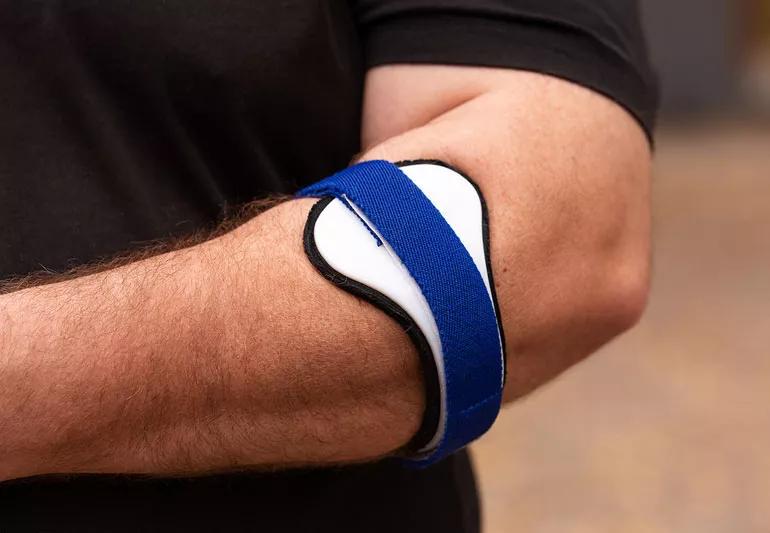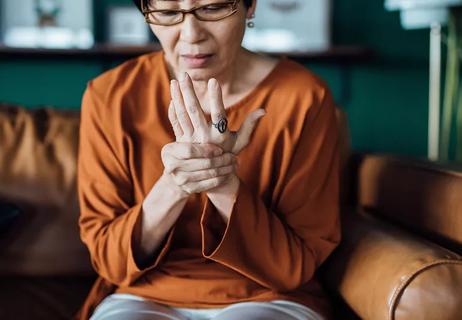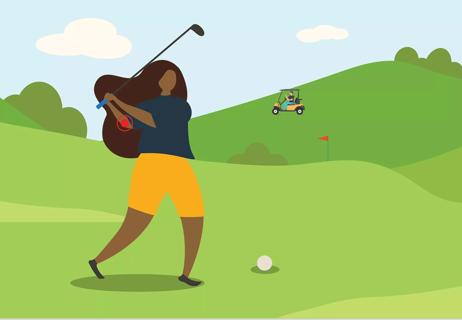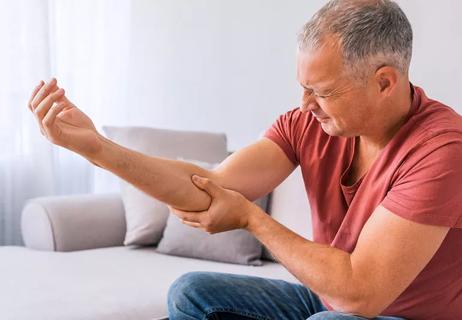Learn how this simple piece of equipment can help relieve elbow pain

If you have medial epicondylitis, better known as golfer’s elbow, wearing a special brace around your forearm can help with symptoms. But with a seemingly endless selection, how do you choose the best brace for you?
Advertisement
Cleveland Clinic is a non-profit academic medical center. Advertising on our site helps support our mission. We do not endorse non-Cleveland Clinic products or services. Policy
Physical therapist Matt Popiolkowski, PT, DPT, explains the ins and outs of selecting a brace for golfer’s elbow pain.
Golfer’s elbow happens when your forearm muscle attachment on the inside crook of your elbow becomes inflamed. These muscles are responsible for flexing your wrist and fingers, and repeated or intense movements can strain them.
“The muscle and tendon tissues become disorganized and can be inflamed, so they can’t function normally,” explains Dr. Popiolkowski. “We see it in people who play sports where they throw, swing or weight lift and have jobs where they grip and hold things.”
Elbow and forearm (lower arm) pain are the most common symptoms, especially when you bend your wrist or squeeze something with your hand. But some people also experience wrist and hand weakness or numbness.
“It’s important to figure out what’s causing the condition so you get the right treatment,” Dr. Popiolkowski says. “Rest may calm down your symptoms, but it can’t restore the muscle and tendons’ ability to do their normal workload.”
Dr. Popiolkowski recommends seeing a physical therapist if you think you have golfer’s elbow.
“There’s usually something above or below the elbow that’s making those muscles work too hard or incorrectly,” he says. “A physical therapist can determine the cause of your symptoms, create a plan to get them under control and prevent future issues.”
Advertisement
Most golfer’s elbow braces are counterforce braces with hook and loop closures and a raised padded surface that you put directly over your affected muscle.
“When you tighten the strap, the raised area puts added pressure directly to the muscles affected below the painful attachment on the elbow,” explains Dr. Popiolkowski. “The pressure of the strap helps reduce pain and strain on those muscles. Use it to help in the short-term while you work on a long-term fix with your physical therapist.”
A long-term fix typically involves stretches and exercises to help rebuild strength and function in your arm.
Many companies make golfer’s elbow braces, but Dr. Popiolkowski says they all follow the same basic design and are equally effective. Some consist of just a strap while others also have built-in compression sleeves. (A compression sleeve is a wide band of fabric made of tight, stretchy material that you wear around your arm.)
“While there are a ton of different varieties, there’s no definitive research pointing to one specific brand or type because they all work the same,” says Dr. Popiolkowski. “Using only a compression sleeve may be more helpful after the condition has improved. They help keep the area warm and blood circulating. While they do not provide much from a support standpoint, many people like the compression feel.”
Golfer’s elbow braces typically come in small, medium and large sizes. Measure around your forearm just below your elbow and follow the size chart the manufacturer provides. Dr. Popiolkowski says you should wear the brace around the thickest part of your forearm, about two finger widths down from your elbow.
“A proper-fitting brace should feel snug — but if you start to see any skin discoloration or feel tingling, it’s too tight,” says Dr. Popiolkowski. “You should be able to comfortably slip a finger underneath the non-padded parts.”
For a final fit test:
Wear your brace during daily activities that involve using your affected arm. Over time, you may only need to wear it while playing sports or performing tasks that aggravate your symptoms. Don’t wear it while you sleep because it could negatively affect your circulation.
The answer depends on your injury. The more severe it is, the longer you may benefit from wearing a forearm brace for golfer’s elbow. You’ll most likely need to wear it for at least a few weeks.
Advertisement
Your physical therapist can help you get the right fit and recommend the best length of time for your situation.
To prevent a recurring golfer’s elbow “Groundhog Day,” Dr. Popiolkowski recommends maintaining:
If you’re experiencing golfer’s elbow symptoms, it’s important to address them quickly. (Ironically, a lot of amateur golfers get tennis elbow instead of golfer’s elbow. Tennis elbow is the same issue, except on the outside of the elbow.)
Advertisement
Learn more about our editorial process.
Advertisement

What to know before seeking medical attention

Plus, exercises and movements to avoid

Remedies and new options for tennis elbow

Your knees could be hurting at bedtime because of inflammation, injury or some other condition that gets worse with pressure and positioning

Hanging upside down for any length of time may decompress the tension in your spine

Stretches, exercises and posture changes can help address lower cross syndrome

To avoid swimmer’s eye, wear goggles, use eye drops and flush out your eyes with fresh, clean water when irritated

Keep kids safe while they swim by staying vigilant and setting up a safe pool environment

Babies can get congested easily, but you can calm their cough by keeping them hydrated, using nasal drops and running a humidifier

Weight loss may cause loose, sagging skin and muscle loss to your rear

Several conditions, like vitiligo and fungal infection, can cause a loss of pigmentation, leading to white spots or patches on your skin